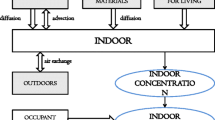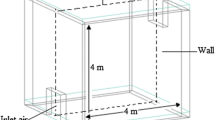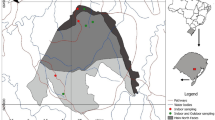Abstract
A known relationship exists between high radon concentrations and lung cancer, and therefore, the indoor radon quantification is important, and it is beneficial to have a model to estimate indoor concentration. The work is focused on the development of an INDORAD (INDOor RAdon Dynamic) model for estimation of indoor radon dynamics, with time-dependent meteorological parameters and adjustable soil and building properties being considered. This model is based on a systemic approach, where the flows of material between compartments are considered, without a spatial resolution. This approach allowed to simplify the mathematical processing and enabled to consider together all known sources of indoor radon. The developed model was put in use in a laboratory building where soil constitutes major source of radon. The results (radon concentrations) from the model were compared to an existing data set from Saelices el Chico in a soil with high concentration of 226Ra. The outcome of the validation implies that INDORAD could predict radon concentrations satisfactorily. Suggestions for future updates of the model to improve indoor radon estimations are provided.
Graphical abstract






Similar content being viewed by others
Availability of data and materials
The datasets used and/or analyzed during the current study are available from the corresponding author on reasonable request.
References
Arvela H, Holmgren O, Haenninen P (2015) Effect of soil moisture on seasonal variation in indoor radon concentration: modelling and measurements in 326 Finnish houses. Radiat Prot Dosim 168(2):277–290
Baskaran M (2016) Radon: a tracer for geochemical exploration. In: Radon: A Tracer for Geological, Geophysical and Geochemical Studies. Springer Geochemistry. Springer, Cham. https://doi.org/10.1007/978-3-319-21329-3_9
Bruno R (1983) Sources of indoor radon in houses: a review. J Air Pollut Control Assoc 33(2):105–109. https://doi.org/10.1080/00022470.1983.10465550
Chang JC, Hanna SR (2004) Air quality model performance evaluation. Meteorog Atmos Phys 87:167–196
Chen J, Bergman L, Falcomer R, Whyte J (2015) Results of simultaneous radon and thoron measurements in 33 metropolitan areas of Canada. Radiat Prot Dosim 163(2):210–216. https://doi.org/10.1093/rpd/ncu141
Council Directive (1996) 1996/29/EURATOM of 13 May 1996 laying down basic safety standards for the protection of the health of workers and the general public against the dangers arising from ionizing radiation. Off J L 159:0001–0114
Council Directive (2013) 2013/59/EURATOM of 5 December 2013 laying down basic safety standards for protection against the dangers arising from exposure to ionising radiation, and repealing Directives 89/618/Euratom, 90/641/Euratom, 96/29/Euratom, 9/43/Euratom and 2003/122/Euratom.
Darby S, Hill D, Auvinen A, Barros-Dios JM, Baysson H, Bochicchio F, Deo H, Falk R, Forastiere F, Hakama M, Heid I, Kreienbrock L, Kreuzer M, Lagarde F, Mäkeläinen I, Muirhead C, Oberaigner W, Pershagen G, Ruano-Ravina A, Ruosteenoja E, Rosario AS, Tirmarche M, Tomásek L, Whitley E, Wichmann HE, Doll R (2005) Radon in homes and risk of lung cancer: collaborative analysis of individual data from 13 European case-control studies. Br Med J 330(7485):223
Dixon D (2001) Radon exposures from the use of natural gas in buildings. Radiat Prot Dosim 97(3):259–264. https://doi.org/10.1093/oxfordjournals.rpd.a006671
Dvorzhak A, Mora JC, Robles B (2016) Probabilistic risk assessment from potential exposures to the public applied for innovative nuclear installations. Reliab Eng Syst Saf 152:176–186
EPA (2003) Assessment of risks from radon in homes. US Environmental Protection Agency, Office of Radiation and Indoor Air, Washington
Fleisher RL, Hart HR, Mogro-Campero A (1980) Radon emanation over an ore bode: search for long-distance transport of radon. Nucl Instrum Method 173:169–181
Font L, Baixeras C (2003) The RAGENA dynamic model of radon generation, entry and accumulation indoors. Sci Total Environ 307:55–69
Frutos Vázquez B, Olaya Adán M, Esteban Saiz JL (2011) Acciones de rehabilitación frente a la entrada de gas radón. Ingeniería de Construcción 26(1):95–121
IAEA (1996) International basic safety standards for protection against ionizing radiation and for the safety of radiation sources. INTERNATIONAL ATOMIC ENERGY AGENCY, Vienna, p 370
ICRP, 2010. Lung cancer risk from radon and progeny and statement on radon. ICRP Publication 115. Ann. ICRP 40(1).
ICRP, 2014. Radiological protection against radon exposure. ICRP Publication 126. Ann. ICRP 43(3).
ICRP (2017) Occupational intakes of radionuclides: Part 3. ICRP Publication 137. Ann ICRP 46(3/4):1–486. https://doi.org/10.1177/0146645317734963
ICRP, (2019). Radiological protection from naturally occurring radioactive material (NORM) in industrial processes. ICRP Publication 142. Ann. ICRP 48(4).
ISO 11665-11, (2016). Measurement of radioactivity in the environment -- Air: radon-222 -- Part 11: Test method for soil gas with sampling at depth.
Khattak NU, Asif KM, Ali N, Muntazir SA (2011) Radon monitoring for geological exploration: a review. J Himalayan Earth Sci 44(2):91–102
King CY, Minissale A (1994) Seasonal variability of soil-gas radon concentration in central California. Radiat Meas 23(4):683–692
Kunz C (1988) Indoor radon: source characterization. Environ Prog 7:236–240. https://doi.org/10.1002/ep.3300070411
Markkanen M, Arvela H (1992) Radon emanation from soils. Radiat Prot Dosim 45(1):269–272
Medici F, Rybach L (1994) Measurements of indoor radon concentrations and assessment of radiation exposure. J Appl Geophys 31(1–4) ISSN 0926-9851:153–163. https://doi.org/10.1016/0926-9851(94)90054-X
Mueller Associates, Inc (1988) SYSCON Corporation and Brookhaven National Laboratory. In: Handbook of Radon in Buildings: Detection, Safety, and Control. Hemisphere Publishing Corporation, USA.
Nagda NL. 1994. Radon: prevalence, measurements, health risks and control. American Society for Testing and Materials, Philadelphia, PA. Niren L. Nagda (Eds.).
National Institute of Standards and Technology (NIST). (2021) Available at: https://physics.nist.gov/cuu/Uncertainty/coverage.html (accessed April 8, 2021).
Nazaroff WW (1992) Radon transport from soil to air. Rev Geophys 30:137–160
Nazaroff W, Nero A (eds) (1988) Radon and its decay products in indoor air. Wiley-Interscience, New York
Organization for Economic Cooperation and Development, OECD. (2009). Exposure to radiation from natural radioactivity in building materials. Report by a group of experts of the OECD. Nuclear Energy Agency.
Otton JK 1992. The Geology of Radon, U.S. Geological Survey Open File Report.
Park JH, Kang DR, Kim J (2016) A review on mathematical models for estimating indoor radon concentrations. Ann Occup Environ Med 28:7. https://doi.org/10.1186/s40557-016-0091-6
Park JH, Whang S, Lee HY, Lee C-M, Dae RK (2018) Measurement and modelling of indoor radon concentrations in residential buildings. Environ Health Toxicol 33(1):1–8
Quindós Poncela L, Sainz C, Gutiérrez-Villanuevam J, Fuente I, Celaya S, Quindós López L, Quindós López J, Fernández E, Fernández A (2016) The Laboratory of Natural Radiation (LNR) – a place to test radon instruments under variable conditions of radon concentration and climatic variables. NUKLEONIKA 61(3):275–280. https://doi.org/10.1515/nuka-2016-0046
Robinson AL, Sextro RG (1995) The influence of a subslab gravel layer and open area on soil-gas and radon entry into two experimental basements. Health Phys 69(3):367–377
Rogers VC, Nielson KK (1991) Multiphase radon generation and transport in porous materials. Health Phys 60:807–815
Sainz Fernández C, Quindos Poncela LS, Fernández Villar A, Fuente Merino I, Gutiérrez-Villanueva JL, Celaya González S, Quindos López L, Quindos López J, Fernández E, Remondo Tejerina J, Martín Matarranz JL, García Talavera M (2016) Spanish experience on the design of radon surveys based on the use of geogenic information. J Environ Radioact 166(2):390–397. https://doi.org/10.1016/j.jenvrad.2016.07.007
Schubert M, Musolff A, Weiss H (2018) Influences of meteorological parameters on indoor radon concentrations (222Rn) excluding the effects of forced ventilation and radon exhalation from soil and building materials. J Environ Radioact 192:81–85. https://doi.org/10.1016/j.jenvrad.2018.06.011
Skubacz K, Wysocka M, Michalik B, Dziurzyński W, Krach A, Krawczyk J, Pałka T (2019) Modelling of radon hazards in underground mine workings. Sci Total Environ 695:1–8. https://doi.org/10.1016/j.scitotenv.2019.133853
Spotar S, Ibrayev N, Uyzbayeva A, Atabayev J (2018) Non-uniformity of the indoor radon concentration under a convective mixing mechanism. Int J Environ Res Public Health 15(12):2826. https://doi.org/10.3390/ijerph15122826
Sun Q, Tikami S, Yamada Y, Akiba S (2002) Main meteorological parameters to influence indoor radon level. Radioisotopes 51:120–126
TERRITORIES (2019) Deliverable 9.61 – Guidance to select level of complexity. EJP-CONCERT. European Joint Programme for the Integration of Radiation Protection Research: H2020–662287
UNSCEAR (1988) Sources, effects and risks of ionizing radiation (UN, New York). UNSCEAR Report of the United Nations Scientific Committee on the Effects of Atomic Radiation to the General Assembly, with annexes. United Nations, New York
WHO, (2009). WHO Handbook on indoor radon. A public health perspective. WORLD HEALTH ORGANIZATION, Geneva.
Zhukovsky MV, Kruzhalov AV, Gurvich VB, Yarmoshenko IV (2000) Radon safety of buildings. Ural Branch of the Russian Academy of Sciences, Yekaterinburg ISBN 5-7691- 1088–0
Funding
This research was supported by the CIEMAT (Centro de Investigaciones Energéticas, Medioambientales y Tecnológicas), Environmental Department, Unit of Radiation Protection for the Public and the Environment
Author information
Authors and Affiliations
Contributions
Alla Dvorzhak: conceptualization, methodology, software, writing original draft preparation, visualization, and results analysis. Juan Carlos Mora: conceptualization, methodology, writing—reviewing and editing, and results analysis. Almudena Real: supervision, conceptualization, methodology, and writing—reviewing and editing. Carlos Sainz: data measurements, data curation, and results analysis. Ismael Fuente: data measurements, data curation, and results analysis.
Corresponding author
Ethics declarations
Ethics approval and consent to participate
“Not applicable.”
Consent for publication
“Not applicable.”
Competing interests
The authors declare no competing interests.
Additional information
Responsible Editor: Georg Steinhauser
Publisher’s note
Springer Nature remains neutral with regard to jurisdictional claims in published maps and institutional affiliations.
Rights and permissions
About this article
Cite this article
Dvorzhak, A., Mora, J.C., Real, A. et al. General model for estimation of indoor radon concentration dynamics. Environ Sci Pollut Res 28, 54085–54095 (2021). https://doi.org/10.1007/s11356-021-14422-3
Received:
Accepted:
Published:
Issue Date:
DOI: https://doi.org/10.1007/s11356-021-14422-3




